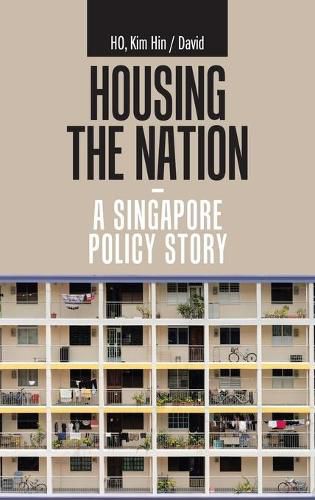Readings Newsletter
Become a Readings Member to make your shopping experience even easier.
Sign in or sign up for free!
You’re not far away from qualifying for FREE standard shipping within Australia
You’ve qualified for FREE standard shipping within Australia
The cart is loading…






This title is printed to order. This book may have been self-published. If so, we cannot guarantee the quality of the content. In the main most books will have gone through the editing process however some may not. We therefore suggest that you be aware of this before ordering this book. If in doubt check either the author or publisher’s details as we are unable to accept any returns unless they are faulty. Please contact us if you have any questions.
Chapter 1 takes a close look at a unique and state-of-the-art dynamic, structural public housing macroeconomic model (DSPHM), based on an open economy for several key macroeconomic variables, actual and expected, as well as the demand for new HDB flats sold. This Chapter readily adopts the DSPHM for simulating two scenarios, namely a no change first scenario and a public housing deregulation second scenario. Chapter 2 explores the relationship between several economic factors and the demand for public housing in Singapore and Hong Kong, deploying the innovative and versatile system dynamics model, to shed better understanding on the policy implications of assisted ownership housing. The Chapter assesses the demand for new flats of the Singapore and Hong Kong economies, under certain macroeconomic policy changes, suitable for their unique situations. Chapter 3 is concerned with the underlying structural relationships that affect Singapore’s public housing policy to potentially privatize the HDB concessionary-rate mortgages for HDB homebuyers. Such a potential privatization infuses and sustains price competitiveness among the domestic private banks in Singapore, and lead to improved efficiency among them as well as the Singapore economy at large. Chapter 4 is concerned with the binomial option-pricing model, proposed by Cox, Ross and Rubinstein (1979), which is appropriate to represent the movement of the underlying HDB resale flat prices, subject to private market forces in HDB’s large scale public housing secondary resale market. The HDB Main Upgrading Program (MUP) is a heavily subsidized and highly targeted public housing policy. Since its inception in 1992, the HDB has budgeted some S$3 billion to finance the MUP policy. Chapter 5 recognizes housing affordability to be always an issue of concern to many Singaporean homebuyers because shelter forms one of the basic life necessities. The corresponding private residential market in Singapore offers quality and premium private residential accommodation for homebuyers, who prefer the private residential market. The appropriate affordability model is a multi-factor housing affordability index (HAI) model, which considers the ability to provide down payment and to service the mortgage taken up. Lastly, Chapter 6 offers the book’s conclusion.
$9.00 standard shipping within Australia
FREE standard shipping within Australia for orders over $100.00
Express & International shipping calculated at checkout
This title is printed to order. This book may have been self-published. If so, we cannot guarantee the quality of the content. In the main most books will have gone through the editing process however some may not. We therefore suggest that you be aware of this before ordering this book. If in doubt check either the author or publisher’s details as we are unable to accept any returns unless they are faulty. Please contact us if you have any questions.
Chapter 1 takes a close look at a unique and state-of-the-art dynamic, structural public housing macroeconomic model (DSPHM), based on an open economy for several key macroeconomic variables, actual and expected, as well as the demand for new HDB flats sold. This Chapter readily adopts the DSPHM for simulating two scenarios, namely a no change first scenario and a public housing deregulation second scenario. Chapter 2 explores the relationship between several economic factors and the demand for public housing in Singapore and Hong Kong, deploying the innovative and versatile system dynamics model, to shed better understanding on the policy implications of assisted ownership housing. The Chapter assesses the demand for new flats of the Singapore and Hong Kong economies, under certain macroeconomic policy changes, suitable for their unique situations. Chapter 3 is concerned with the underlying structural relationships that affect Singapore’s public housing policy to potentially privatize the HDB concessionary-rate mortgages for HDB homebuyers. Such a potential privatization infuses and sustains price competitiveness among the domestic private banks in Singapore, and lead to improved efficiency among them as well as the Singapore economy at large. Chapter 4 is concerned with the binomial option-pricing model, proposed by Cox, Ross and Rubinstein (1979), which is appropriate to represent the movement of the underlying HDB resale flat prices, subject to private market forces in HDB’s large scale public housing secondary resale market. The HDB Main Upgrading Program (MUP) is a heavily subsidized and highly targeted public housing policy. Since its inception in 1992, the HDB has budgeted some S$3 billion to finance the MUP policy. Chapter 5 recognizes housing affordability to be always an issue of concern to many Singaporean homebuyers because shelter forms one of the basic life necessities. The corresponding private residential market in Singapore offers quality and premium private residential accommodation for homebuyers, who prefer the private residential market. The appropriate affordability model is a multi-factor housing affordability index (HAI) model, which considers the ability to provide down payment and to service the mortgage taken up. Lastly, Chapter 6 offers the book’s conclusion.